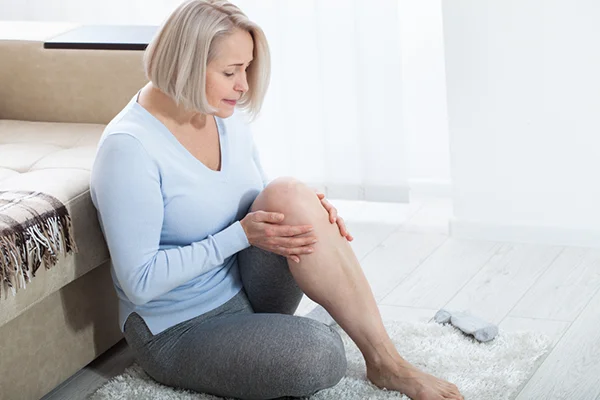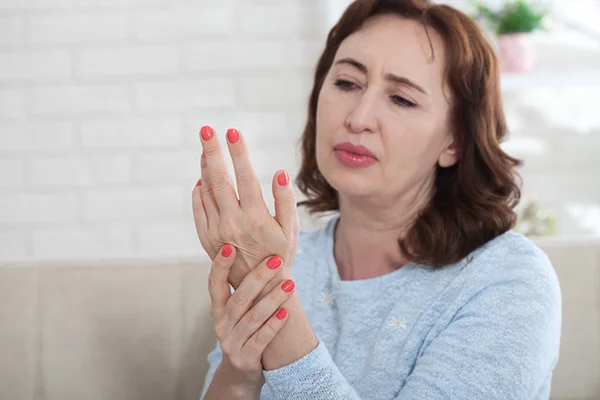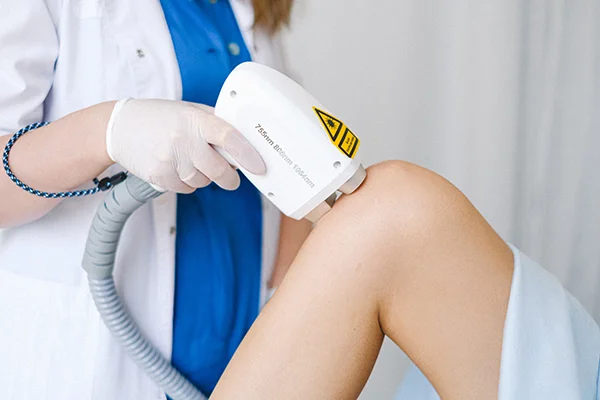Are you one of the many women who experience joint pain during menopause? You’re not alone. Joint pain is a common symptom that can make everyday activities feel like a challenge. But fear not! We’ve got your back with this practical guide, where we’ll walk you through the relationship between menopause and joint pain, how to recognize it, and effective ways to find relief. Let’s dive in and explore the world of managing menopause and joint pain together!
Key Takeaways
- Understand how menopause & joint pain are linked to estrogen levels, lifestyle factors, and diet.
- Recognize symptoms like morning stiffness & swelling, then use exercise, nutrition changes, relaxation techniques for relief.
- If self care isn’t working seek professional help – look out for warning signs of severe pain or difficulty using a joint.
Understanding Menopause and Joint Pain

Menopausal joint pain primarily stems from decreased estrogen levels, which affect estrogen receptors in the joints. As joint pain affects many women, some report that menopause joint pain feel is one of their first menopausal symptoms, making it crucial to address this issue early on. Other factors like weight, lifestyle, and diet can also contribute to this unpleasant symptom.
Weight-bearing joints like the knees and hips are typically affected by menopause joint pain, but it can also impact other joints in the body. Fortunately, there are practical tips for relieving menopause joint pain, including exercise, diet, and stress management.
We will examine the significance of estrogen in joint health and other factors that contribute to joint pain.
The Role of Estrogen in Joint Health
Estrogen is a key hormone in maintaining joint health, as it helps keep cartilage and other joint tissues in good shape, preventing conditions like rheumatoid arthritis. When estrogen levels decline during menopause, it can lead to:
- Joint pain
- Aches
- Stiffness
- Joint inflammation
These symptoms, including aches and pains, can cause discomfort and disrupt daily activities.
We will also inspect other elements that can intensify joint pain during menopause, such as hot flashes.
Other Contributing Factors to Menopausal Joint Pain
In addition to hormonal changes, other factors can exacerbate joint pain during menopause. These factors include:
- Excess weight
- A sedentary lifestyle
- An unhealthy diet
- Smoking
- Stress
All of these can contribute to worsening joint pain for menopausal women.
For instance, smoking can increase joint pain and chronic pain in general, as well as aggravate menopause symptoms. Losing weight can help protect your joints during menopause and prevent painful joints. Addressing these factors is vital for the effective management of joint pain related to menopause.
Recognizing Menopause-Related Joint Pain

Menopause joint pain can manifest in various ways, such as:
- Stiffness
- Tightness
- A dull ache
- A burning sensation
- Occasional shooting pains
The most commonly affected joints include the knees, hips, and shoulders.
Identifying joint pain related to menopause requires monitoring the location and type of pain, the frequency and duration of pain, accompanied by any additional symptoms. We will delve into the prevalent symptoms and the joints affected.
Common Menopause Symptoms

Some common symptoms of menopause-related joint pain include:
- Morning stiffness: characterized by stiffness and pain in the joints when you wake up
- Swelling: occurs when the size of the joint increases due to inflammation
- Varying levels of pain intensity: can range from mild to severe, depending on the individual and the affected joint.
We will now investigate which joints are predominantly affected by joint pain related to menopause.
Affected Joints
While menopause joint pain typically affects weight-bearing joints like knees and hips, it can also impact other joints such as shoulders, wrists, and fingers. Being aware of the joints commonly affected by menopause-related joint pain can help you better manage the discomfort and seek appropriate treatments.
Having identified the symptoms and the affected joints, we will now examine some practical relief measures for joint stiffness.
Practical Tips for Relieving Menopause Joint Pain

Dealing with menopause joint pain can be challenging, but there are practical strategies to help alleviate the discomfort. Regular low-impact exercise, a balanced diet rich in anti-inflammatory foods, and stress management techniques can all provide relief.
We will delve into each of these tips in further detail, beginning with exercise and physical activity.
Exercise and Physical Activity
Engaging in low-impact exercises like yoga, swimming, and walking can help alleviate joint pain during menopause. These activities keep the joints flexible and strengthen the muscles without overworking them, providing relief from discomfort. Additionally, exercise can help you maintain a healthy weight and reduce inflammation, further contributing to joint pain relief.
Next, we will examine the influence of diet and nutrition in managing joint pain during menopause.
Diet and Nutrition
Consuming a diet rich in anti-inflammatory foods can help reduce joint pain during menopause. Some examples of anti-inflammatory foods include:
- Fruits
- Vegetables
- Whole grains
- Omega-3 fatty acids
These foods work by reducing inflammation in the joints, providing relief from pain and discomfort. Additionally, maintaining a balanced diet can help you maintain a healthy weight, which is crucial for joint health.
Next, we will consider stress management and relaxation techniques to relieve joint pain and alleviate its symptoms.
Stress Management and Relaxation Techniques

Practicing relaxation techniques like mindfulness, meditation, and deep breathing can help manage stress and reduce joint inflammation during menopause. These techniques promote relaxation, which can help alleviate joint pain and improve overall well-being. By incorporating these stress management techniques into your daily routine, you can lessen the impact of menopause-related joint pain and enhance your quality of life.
We will now talk about the available medical treatments for joint pain during menopause.
Medical Treatments for Menopause Joint Pain
While lifestyle changes can help manage menopause joint pain, medical treatments are also available. Over-the-counter painkillers and hormone replacement therapy (HRT) are common treatments that may offer relief.
We will further examine these medical treatments and their effectiveness in alleviating joint pain during menopause.
Over-the-Counter Medications
Over-the-counter medications like acetaminophen and ibuprofen can help manage joint pain during menopause. These medications work by alleviating inflammation and pain, providing temporary relief from discomfort. However, it’s essential to follow the recommended dosages and consult your healthcare provider if the pain persists or worsens.
We will now consider hormone replacement therapy (HRT) as a potential treatment for joint pain during menopause.
Hormone Replacement Therapy (HRT)
HRT can effectively relieve menopause-related joint pain by addressing hormonal imbalances. It involves taking estrogen medication to replace the hormones that the body no longer produces, alleviating menopause symptoms like joint pain. However, HRT can have side effects like a higher risk of stroke, heart attack, and blood clots, so it’s essential to discuss the pros and cons with your healthcare provider before starting treatment.
Having discussed the medical treatments, we will now explore when it is appropriate to seek professional help for joint pain during menopause.
When to Seek Professional Help

Seeking professional help is critical if menopause joint pain symptoms worsen, are accompanied by other alarming symptoms, or if self-care measures prove ineffective. Your healthcare provider can help diagnose the cause of the pain and recommend appropriate treatment options.
We will discuss the warning signs that necessitate medical attention and the process of finding the right specialist.
Warning Signs
Severe pain, joint swelling, redness, or the inability to use the joint are all warning signs that require medical attention. If you notice any sudden changes to the joint or if you’re experiencing joint pain that is intense, it’s time to consult a professional. Early intervention can help prevent further joint damage and improve your quality of life.
We will now discuss the process of finding an appropriate specialist to deal with joint pain related to menopause.
Finding the Right Specialist
Finding the right specialist, such as a rheumatologist or menopause expert, can help diagnose and treat menopause-related joint pain effectively. When selecting a specialist, consider their experience, qualifications, and reputation. You can also ask for referrals from friends and family or read online reviews to find a healthcare provider who suits your needs.
With the right specialist by your side, you can navigate menopause joint pain with confidence and expertise.
Summary
In conclusion, menopause-related joint pain can be challenging to manage, but with the right knowledge and strategies, you can find relief. By understanding the role of estrogen in joint health, recognizing the symptoms and affected joints, and implementing practical tips like exercise, diet, and stress management, you can take control of your joint pain. Don’t hesitate to seek professional help if symptoms worsen or self-care measures are ineffective. Remember, you’re not alone in this journey; countless women face menopause-related joint pain, and together we can overcome it!
Frequently Asked Questions
Will joint pain from menopause go away?
Joint pain from menopause may not go away, but there are lifestyle changes that can help ease the pain and prevent it from getting worse. Eating anti-inflammatory foods can be beneficial in reducing the pain.
What helps joint pain during menopause?
Painkillers like Ibuprofen and Tylenol, as well as cold/hot compresses, can help alleviate joint pain during menopause. Listen to your body and check in with your doctor for more advice.
What does menopause joint pain feel like?
Menopause joint pain can feel like a dull ache, a twinge, or a shooting sensation in the joints, as well as stiffening. It can also radiate from tendons, muscles and bones.
When should I seek professional help for menopause-related joint pain?
If your menopause-related joint pain worsens, is accompanied by other concerning symptoms, or if self-care measures are ineffective, it’s time to seek professional help. Your healthcare provider can help diagnose the cause and recommend the best treatment options.
About PatchMD
PatchMD topical vitamin patches offer a solution for those looking to work through nutrient deficiencies and finding a creative way to take their vitamin supplements. Whether you have had a bariatric surgery an issue with absorbing pills or just issues with compliance, our top products like multivitamin patches, kids multivitamin, hangover plus (now Happy Hour), B12 Energy plus, Vitamin D3, the C Plus vitamin patch, our new L-lysine/Zinc Plus patch and so many more! Free Shipping over $59. Learn More about PatchMD’s Menopause Day Relief Patch and PatchMD’s Menopause Night Relief Patch.









Leave A Comment
You must be logged in to post a comment.